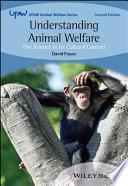Understanding Animal Welfare – The Science in its Cultural Context 2nd Edition

Understanding Animal Welfare, 2nd Edition je revidováno a rozšířeno tak, aby zahrnovalo nový výzkum a vývoj v oblasti dobrých životních podmínek zvířat. Aktualizováno s ohledem na větší dostupnost, čtenář je proveden dobrými životními podmínkami zvířat v jejich kulturním a historickém kontextu, metodami studia a aplikacemi v praxi a politice. Text čerpající z příkladů z farmářských, společenských, laboratorních a zoologických zvířat poskytuje aktuální přehled výzkumu a jeho aplikací a zároveň sleduje, jak se koncepty a metody vyvíjely v průběhu času.
Čtenáři druhého vydání knihy Understanding Animal Welfare také najdou:
Nový vývoj v chápání pozitivních stavů zvířat
Význam lidského jednání při určování dobrých životních podmínek zvířat
Nový obsah na „One Welfare“
Jak jsou volně žijící divoká zvířata ovlivněna lidskou technologií a změnou klimatu
Understanding Animal Welfare , původně určený pro vědce a odborníky, našel domov také v vysokoškolských učebnách. Nyní je základním textem pro studenty, praktiky, veterináře a výzkumníky v oblasti dobrých životních podmínek zvířat a příbuzných oborech.
David Fraser, CM, PhD, je emeritním profesorem v programu Animal Welfare na University of British Columbia, Vancouver, Kanada. Díky 50 letům výzkumu na farmách, společenských, laboratorních a divokých zvířatech je uznáván jako průkopník vědy o dobrých životních podmínkách zvířat.
Autor: Fraser
| Nakladatel | Wiley-Blackwell |
|---|---|
| ISBN | 9781119626442 |
| Vydání | II. vydání 2023 |
| Vazba | brožovaná |
| Počet stran | 384 |
Understanding Animal Welfare, 2nd Edition is revised and expanded to incorporate new research and developments in animal welfare. Updated with greater accessibility in mind, the reader is guided through animal welfare in its cultural and historical context, methods of study, and applications in practice and policy. Drawing examples from farm, companion, laboratory and zoo animals, the text provides an up-to-date overview of research and its applications, while also tracing how concepts and methods have evolved over time.
Readers of the second edition of Understanding Animal Welfare will also find:
New developments in understanding positive animal states
The importance of human actions in determining animal welfare
New content on “One Welfare”
How free-living wild animals are affected by human technology and climate change
Originally intended for scientists and professionals, Understanding Animal Welfare has also found a home in undergraduate classrooms. It is now the essential text for students, practitioners, veterinarians, and researchers in animal welfare and related fields.
| TABLE OF CONTENTS | IX |
| Preface to the Second Edition | ix |
| Acknowledgements | x |
| Introduction | 1 |
| Part I Animal Welfare in Context | 9 |
| 1 Animals in the Human Mind | 11 |
| 2 A Good Life for Animals | 28 |
| 3 A Science of Animal Welfare | 47 |
| Part II Studying Animal Welfare | 63 |
| 4 Disease, Injury and Productivity | 65 |
| 5 ‘Stress’ | 83 |
| 6 Abnormal Behaviour | 104 |
| 7 Affective States | 124 |
| 8 Positive Affect and the Science of Affect | 146 |
| 9 ‘Natural’ Living | 166 |
| 10 Preferences and Motivation | 186 |
| Part III From Science to Policy and Practice | 209 |
| 11 Integrating Different Aspects of Animal Welfare | 211 |
| 12 Policies, Standards and Assessment Programmes | 226 |
| 13 ‘Facts’ and ‘Values’ in Mandated Science | 244 |
| Part IV New Directions | 257 |
| 14 The Human Dimension and ‘One Welfare’ | 259 |
| 15 The Welfare of Free- living Wild Animals | 281 |
| 16 Animal Welfare and the Evolution of Animal Ethics | 299 |
| Coda: Animal Welfare, the Science and the Cultural Context | 314 |
| References | 322 |
| Index | 353 |